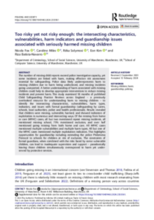The number of missing child reports exceed police investigative capacity, yet some incidents are linked with harm, making effective risk assessment essential for safeguarding. Police data likely underrepresents harm to missing children due to harm being undisclosed, and missing incidents going unreported. A better understanding of harm associated with missing children could help to develop appropriate interventions to reduce missing incidents and prevent harm.
This study examined 18 months of published Child Safeguarding Practice Reviews across England – a previously overlooked resource for understanding harm to missing children – to identify the intersecting characteristics, vulnerabilities, harm types, indicators, and issues with formal guardianship (safeguarding by carers, schools, local authorities, police and health professionals). Results revealed that children were missing, vulnerable, harmed, and showed indicators of exploitation in numerous and intersecting ways.
Of the missing from home or care (MFHC) cases, all but two mentioned repeat missing incidents, all mentioned missing school, 75% mentioned exclusion, and over half mentioned going missing from both home and care. All MFHC cases mentioned multiple vulnerabilities and multiple harm types. All but one of the MFHC cases mentioned multiple exploitation indicators. This highlights opportunities for guardianship including extending the police Philomena Protocol to schools for children at risk of exclusion.
The constraints of formal guardians, when combined with the risks faced by some vulnerable children, can lead to inadequate supervision and support – paradoxically leaving those children simultaneously overexposed to harm yet underserved by protective services.

